“The Engine” is quickly becoming a popular choice among guitar players that want to add some 60s British distortion to their playing with a boost. DryBell has created what they call a “foundation preamp.” In this DryBell The Engine review, I tell you everything you need to know about this extraordinary effects unit.
Keep in reading to learn what this “must-have” little box can do to give your amp the vintage, “no master volume” sound it deserves, and do it at a volume level that won’t wake the neighbors!
What Is The Engine
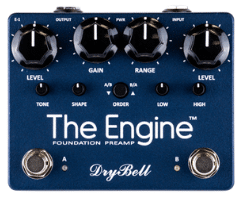
The Engine is Drybell’s stompbox that gives you both a British distortion circuit (the “A” Side) and a range booster circuit (the “B” side).
This Croatian company (super-genius Nikola Tesla was Croatian) has created a pedal that allows you to use each side individually, but the real magic happens when you use them simultaneously.
These two circuits (channels) are separately configurable. They can be set so that the distortion signal feeds into the range booster (A –>B) or with the range booster signal feeding the distortion channel (B–>A).
Who Is This Pedal For?
The Engine is for anyone who wants to dial in the best possible 60 British overdrive or distortion, no matter which amp they are plugged into, and be able to do it at a reasonable volume level.
For example, the vintage Marshall Plexi amps sound good, but the more you crank the volume, the better they sound. There is no master volume control, so if you dime it in a small room you’re in for a deafening experience, especially if the head is connected to two 4X12 cabinets!
With The Engine, you don’t have to move that much air to get the coveted Marshall sound.
How The Engine Works
The Engine is a fully analog foundation preamp that gives you the ability to use each of its two channels alone or in combination with each other. The channels can be combined in both directions (A–>B or B–>A) to give you the full range of possible sounds.
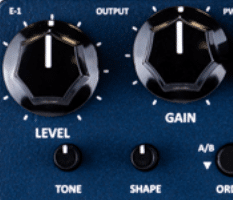
(Side A)
Side A – The British Distortion Channel
Side A is a preamp that allows you to recreate 60s British amp sounds. Think Marshall, Vox, Orange, and other amps of that era.
The preamp has Level, Gain, Tone, and Shape controls that allow you to dial in sounds ranging from overdrive to mild crunch to full-on raging distortion.
The red LED lights up when Side A is active.
The distortion channel can be put before (A–>B) or after (B–>A) the booster channel.
The Shape Control
The shape control can work magic on your setup by adjusting the midrange’s level and “character.” It works in conjunction with the tone control and can make your amp sound more aggressive by giving it more of a “metal-edge,” or you can add a touch of Clapton “woman tone.”
Turn up the Shape control, and you can easily cut through the mix. Turn down the Shape control, and you can tweak up the gain control without the unit slamming your amp’s front-end.
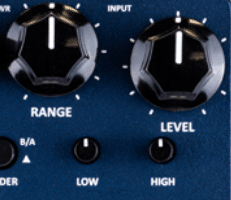
(Side B)
Side B – The Range(master) Channel
Side B is a high-headroom, distortion-free booster with a two-band (low and high) EQ. This preamp boosts the output linearly to keep the signal clean but accentuates the dynamics and harmonics of whatever you play.
It is essentially modeled after DryBell’s Unit 67 Pedal and shares many of its key characteristics, minus the compressor. You can use The Engine in conjunction with the Unit 67 pedal’s 1176-type compressor to get the best of both worlds, giving you sustain with controlled feedback that lasts forever.
The preamp has Range, Level, Low, and High controls to adjust the output and frequency spectrum of the booster.
The white LED lights up when Side B is active.
The booster channel can be put before (B–>A) or after (A–>B) the distortion channel.
The Range Control
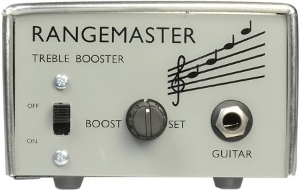
The range control adjusts specific upper-mid frequencies and works with the two-band EQ to allow you to boost your sound in a variety of characteristic ways. Think vintage Dallas Rangemaster on steroids.
By adjusting the Range and EQ controls, you can boost your treble without attenuating your guitar’s bass response.
The Order Switch
The Order switch allows you to stack the distortion circuit (side A) before or after the booster circuit (side B) with the push of a button.

Stacking the distortion side in front of the booster (A–>B) makes your distortion more prevalent and “complex”-sounding with warm overtones. Using this order gives your distortion more girth that backs off and cleans up nicely when you roll down the volume on your guitar.
Stacking the booster side in front of the distortion side (B–>A) really amplifies the distortion level in a way that gives it an “edgy” sound. I like this order better than the A–>B configuration, but the other way also sounds great. The B–>A order really puts your guitar in the foreground and makes your notes explode out of the amp when you dig in with the pick.
Control Summary
Here is a summary of the controls for side A and B of The Engine, in a nut shell.
| Side A Controls | British Distortion Control Function |
|---|---|
| Level | Controls the volume level of Side A |
| Gain | Adds grit and dirt to the tone |
| Tone | Adjusts the high-frequency spectrum |
| Shape | Adjusts the mid-frequency character and level |
| Side B Controls | Boost (RangeMaster) Control Function |
|---|---|
| Level | Controls the volume level of Side B |
| Range | Adjusts specific mid-frequencies to add sparkle and bite |
| Low | Adjusts low frequencies from -15.8dB to +9.3 dB |
| High | Adjusts high-frequencies from -13.2dB to +7.2dB |
Here is a video from DryBell that explains how The Engine works.

Features And Benefits
Here are some of the features and benefits that make this pedal worth a serious look.
It Can Transform The Sound Of Your Amp
The Engine can give an American amp a British accent with just the twist of a few knobs. It can make a mediocre or bad-sounding amp sound good, which can be particularly useful in certain situations, like when you are at a gig and stuck playing through a house guitar amp.
This pedal can really help make your guitar stand out in the mix, especially in venues with bad acoustics or lots of ambient noise.
Two For The Price Of One
The Engine is a pricey pedal but you’re getting double the bang for your buck.
If you want to add a distortion pedal and an overdrive or treble booster to your signal chain, The Engine can save you money with two great pedals built into one unit. The Engine will give you a lot more tonal possibilities with a much better signal-to-noise ratio than using two separate pedals.
It could easily replace any “Marshall In A Box” unit on your pedalboard.
The Engine “Plays Nice” With Other Pedals
The Engine works very nicely in combination with other pedals. Using it with DryBell’s Unit 67 and Vibe Machine will give you an awesome tonal palette.
If you use it on a pedalboard with lots of pedals in front of it, the buffered bypass function will keep the pedal sounding true.
Cranked Sound At “Bedroom Levels”
Turning down the Shape control on the distortion side of The Engine allows you to get the best sound out of your amp at low volume levels, even if it does not have a Master Volume control.
You can get the “full-throttle” sound from your amp that you need to ignite your creativity and inspiration, even during practice sessions.
What I like About The Engine
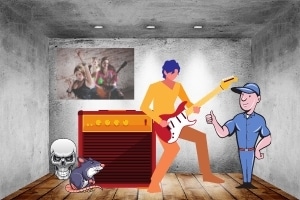
The Engine is very touch-sensitive and open-sounding. Adjusting it to work with the particular guitar and amp you are using is easy, quick, and intuitive.
After you become familiar with how the device functions, then you can readjust it on the fly if you change guitars or switch amps in a live playing situation.
Both sides of The Engine are designed to work well by themselves, but they work even better together because each side was designed to complement and enhance the other. It’s easy to put the distortion or range side in the background by adjusting down that side’s level control.
The Engine uses buffered bypass (not true bypass) to buffer and condition your guitar audio signal’s strength and tone, even when the pedal is bypassed. It is an ultra-low noise buffer circuit with high headroom and virtually no signal loss.
The pedal comes with a 2-year warranty, which is better than the industry standard. If DryBell cannot repair your pedal, they will replace it free of charge. If the unit is no longer available, they will give you a comparable unit of your choice.
What I Don’t Like About The Engine
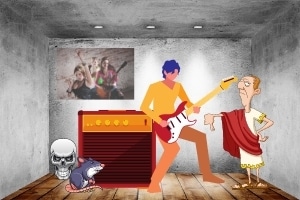
The Engine is a little pricey, so it is not typically a starting pedal for beginner guitar players or people on a tight budget.
This pedal is not built to run on battery power, and rightly so. It needs to be powered by an external power adaptor. DryBell recommends using a regulated 9VDC/100mA (Barrel, Plug 5.5mm/2.1mm, Center Negative) power supply unit, but you can use a maximum of 18 Volts.
Unfortunately, a power supply is not included when you buy the pedal, which will add cost to the unit.
It would be nice to have everything in the box that you need to get up and running. Imagine getting this pedal online after you’ve waited forever to try it and realizing that you can’t use it until you purchase a power supply. What a bummer!
Who Uses DryBell Pedals?
Here is a list of notable guitar players that have used DryBell products. This information was taken directly from DryBell’s website.
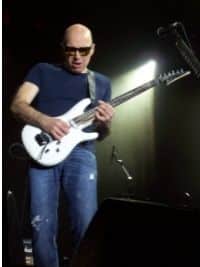
- Michael Landau
- Doyle Bramhall II – Eric Clapton, Roger Waters
- Jon Carin – David Gilmour, Roger Waters
- John Mayer
- Steve Stevens – Billy Idol
- Joe Satriani
- Joe Perry – Aerosmith
- Brad Whitford – Aerosmith
- Eric Gales
- Richard Fortus – Guns N’ Roses
- Charlie Starr – Blackberry Smoke
- Joey Landreth
- Jacob Petersen – The Steve Miller Band
- Owen Barry – Tal Wilkenfeld
- Mick Hayes
- Nick Perri – Silvertide
- Jesse Johnson – The Time
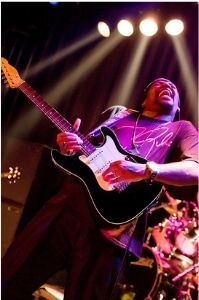
- Vedran Božić – Time
- Vlatko Ćavar Brada – Psihomodo Pop
- Nebojša Antonijević Anton – Partibrejkers
- Miro Lesić
- Bruno Kovačić
- Scott Martinez – Alice Sweet Alice
- JP Cervoni – The Babys
- Gino Matteo – Bennett Matteo Band
- Gwyn Ashton
- Robinson Sartorius
- Jared Scharff – SNL
- Shane Henry
- Francesco D’Andrea
- Bob Fridzema – King King
- Thaddeus Hogarth – Thaddeus Hogarth Band
- Geo Evan Geo – Race No More
- Jason “JJ Boogie” Reichert – Arrested Development
Technical Specifications For The Engine
A review of The Engine from Drybell would not be complete without including all the technical specs for you gearheads out there!
| Specification | Value |
|---|---|
| Input impedance | 900kΩ/1kHz |
| Output impedance | 250 Ω/1kHz |
| Nominal current (with guitar) | 83mA |
| Side A – max output level (9V PSU) | 8.5 Vpp / 11.7 dBu |
| Side A – max output level (18V PSU) | 10.1 Vpp / 13.3 dBu |
| Side A – max gain (all pots on max) | 53dB / (mid-range freq.) |
| Side B – max output level | 20.5 Vpp /19.2 dBu |
| Side B – max gain (all pots on max) | 41.0 dB (mid-range freq.) |
| Max bypass level w/o clipping | 14.0 Vpp / 16.1 dBu |
| Power supply connector type | Barrel, Plug 5.5mm/2.1mm, Center Negative |
| Length (w/o jacks) | 95 mm / 3.74 inch |
| Width | 120 mm / 4.72 inch |
| Height (w/o knobs) | 35 mm / 1.38 inch |
| Weight: (w/o package) | 0.43 kg / 0.95 lb |
| Standard color/finish | Dark blue metallic matte / Powder Coating |
Final Thoughts

The Engine is DryBell’s foundation preamp that gives your amp a variety of vintage non-master volume British sounds. If you need them, modern sounds can be easily dialed in, as well. It can easily cover anything from a Marshall Plexi to a JCM 800 and more.
With the right distortion and Range(master) settings, you can approximate classic sounds, like Tony Iommi’s Rangemaster treble booster into a Laney amp, using the guitar and amp of your choice.
For more information about Tony, see Black Sabbath End Tour – Blu Ray Review – Is That Really It?, and Rock And Roll Hall Of Fame – The Killer Guitar Players!
The two sides of The Engine can work independently or be used together and stacked in two configurations to give an unlimited number of tonal possibilities.
This pedal can add luscious, complex tones and harmonics to your sound. It will take your playing to the next level with touch-sensitive dynamics, even at low volume levels. The Engine helps your guitar’s tone and your playing shine through.
This pedal is truly “The Little Engine That Could!”
For more information, see What Is A Guitar Stomp Box – Attractive, Little, Tantalizing.
Related Article ➡ How To Make A Fender Amp Sound Like A Marshall – Full Guide!

Tell Me What You Think
Please leave a comment below if you enjoyed this DryBell The Engine review, have any questions about this product or want to leave your own personal review. I will be happy to help you.
- Do you own a DryBell The Engine pedal? What do you think of it?
- If not, were you aware that this unit existed?
- How would you use this pedal in the kind of music you play?
- Would you try or buy The Engine after reading this review?


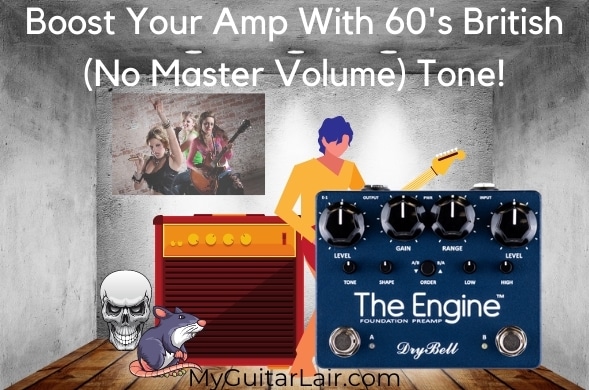

Hello,
Your article is interesting. I can tell you enjoy talking about it. Your tone of excitement comes across until the end.
I am a music lover and can relate somewhat to what you share here. I owned a small vehicle in my younger years, and my boyfriend at the time set up a radio with an amplifier and large booster speakers in it. My brother did the same with his vehicles and even won a trophy for the best stereo system. My present fiancee is also into the amps and stereos in the cars and even has a DJ cousin.
I don’t know much about amplifiers and have never dug deep into this topic. From what you share, this one gives you great sound at levels that don’t interrupt the neighbors, which sounds like a great benefit. I will pass on your site to my family members so they will learn more and offer their comments.
Best wishes, Nyny
Hi, Nyny
Thank You for your comments!
I’m glad you enjoyed the article.
This device is actually a pre-amp that plugs into an electric guitar amp. A good stereo amp, like a car amp, is designed to amplify the sound very accurately. In contrast, good guitar amps are designed to give the sound a certain character, including the ability to add distortion.
If you ever decide to play guitar, then please come back to my website. It will help you get started, and I am always available to answer any questions that you might have.
I really appreciate you passing my article along!
Frank
Thanks for sharing this well written and informative article with us. It looks like a very handy tool if you’re playing electric guitar. Unfortunately, I no longer use the electric and have been accoustic for a number of years now. But thanks for sharing anyway. It was a great read.
Hi, Kwidzin
Thank You for your comments!
There are so many effects units for the electric guitar, new and vintage, that it’s mind-boggling, but The Engine is definitely a great stompbox.
Acoustic guitar is very cool! There are also many stompboxes built specifically for acoustic players.
Please come back to my website now and again. I plan on reviewing some acoustic guitars and amps in the near future.
Frank
Hi Frank!
Before reading your article, I had no idea what the engine is, the purpose of it or how it works. It is really interesting to see and to know who use the DryBell Pedals.
I used to really enjoy playing music, such as the piano, the guitar and the recorder. I feel like I can relate and gain more knowledge from your website.
Thank you for sharing this article with us and I wish you all the best!
Amzy
Hi, Amzy
Thanks for your comments.
If you get an electric guitar, you might eventually be interested in adding some effects pedals to enhance your sound. Don’t ever stop playing music.
Frank
As one of my sons love to play guitar, he often talks about it and he talks about everything that can help him to be better at it, the other night he was talking about the DryBell The Engine and he didn’t stop talking about it, as his mom, I listen to him and then I like to look for some information so I can follow his talk and undestand also why he was so excited about it, after reading your article, I can understand my son and why he is working so hard to save enough money to get it, I will forward him your article, as I’m sure he will love to read it.
Hi, Alejandra
Thank You for your comments!
Wow, what a coincidence, but I’m glad I was able to provide you with just the info that your son might find useful. I appreciate you forwarding it to him, and I hope he enjoys it.
Frank